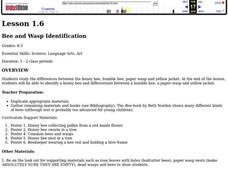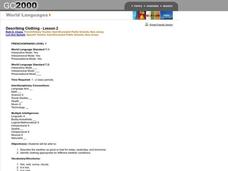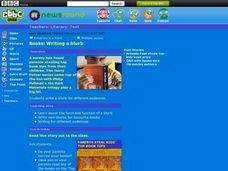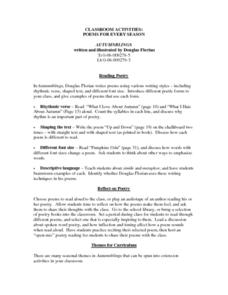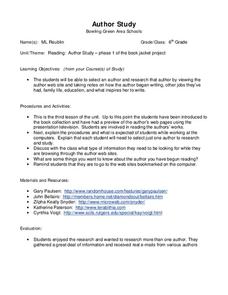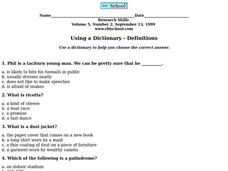Curated OER
Bee and Wasp Identification
Students study the differences between honey bee, bumble bee, paper wasp, and yellow jackets. In this insect classification lesson plan, students study posters of various bees and wasps. Students read the story Holly Honey Bee Story....
Curated OER
We're Going On A Leaf Hunt
Learners read the story We're Going on a Leaf Hunt and read companion stories, make leaves, work with rhyming and word families, and more. In this reading lesson plan, students take 5 days to read the book.
Curated OER
Froggy Gets Dressed
Froggy wants to know: what are you wearing? Lead young Spanish learners through a review of weather-related terms before reading the popular children's book Froggy Gets Dressed. Then, using a froggy puppet, discuss what you're wearing...
Curated OER
Books: Writing a Blurb
Students write a blurb for different audiences. Students encounter different forms and functions of the use of blurbs. Students write an original blurb to share with the class.
Curated OER
Poems for Every Season
Students read and explore autumn poetry. In this poetry lesson plan, students read Autumnblings and are introduced to different poetic forms. Lesson includes ideas for exploring the poetic forms presented in the book and cross-curricular...
Curated OER
Percent of Change, Discounted Price, and Total Price
In this percent of change worksheet, learners find the percent of increase and the percent of decrease. They compute sales tax and determine the final price. Students also figure the discounted price of an item. This one-page...
Curated OER
Joseph Had a Little Overcoat
Students read the story Joseph Had a Little Overcoat about using a coat and making it into many things. In this reading lesson plan, students make a picture out of scraps and discuss how to reuse items to make new items.
Curated OER
The Island of The Blue Eagles
Sixth graders read the book CALL IT COURAGE by Armstrong Sperry. They use the Internet to research and work in groups to write ocean chants. They construct dioramas and build a sea turtle withK'NEX.
Curated OER
In a Nutshell....
Young scholars examine how to summarize the most important details in a reading passage in order to increase their comprehension. They design a story web using the summarization skills. Before class, they complete a reading assignment...
Curated OER
Pronouns: Possessive Pronouns
In this possessive pronouns worksheet, students, in ten sentences, change each pronoun into a possessive pronoun to make each one grammatically correct.
Curated OER
Joseph Had a Little Overcoat Lesson Plan
Students discuss various features of a book, aspects of the story, and then engage in a retelling of the story. In this early childhood lesson plan, students identify the author, illustrator, and title of a book, Joseph Had a Little...
Curated OER
The Patchwork Quilt and Something From Nothing
Students listen to the teacher read the first 26 pages of the story, Something From Nothing, and discuss what predicting means, Students predict how Joesph might remember what his grandfather made him, now that the button is gone. They...
Curated OER
Kidnapped Quiz
In this quiz worksheet, students determine answers to questions taken from Kidnapped by Robert Louis Stevenson. Students answer 25 multiple choice questions.
Curated OER
Dracula
Students read the book, Dracula and complete a variety of listed activities including: class discussion, vocabulary study, rewriting a section of the book in modern language, drawing characters, making a family tree of the characters, etc.
Curated OER
Author Study
Sixth graders complete a research paper on an author of their choice. After selecting an author of interest, 6th graders use internet and traditional resources to gather information from at various sources. They use their information to...
Curated OER
Using a Dictionary- Definitions
In this dictionary use worksheet, students find the definitions of 5 words. They answer multiple choice questions that show they know the meaning of taciturn, ricotta, dust jacket, palindrome, and labyrinth.
Curated OER
Tick Tock Goes The Clock
Young scholars practice letter recognition in written language and sounds for /t/ in both the upper and lower case forms. They utilize a chart with "Today Teddy talked to ten people at two o'clock," on it while making the sounds that are...
Curated OER
Warnings-- Telling Someone Not To Do Something
In this language arts worksheet, young scholars practice choosing the best words to warn someone or tell them not to do something. Students read 10 sentences and pick the best word to fill the blank from 3 choices.
Curated OER
Can you cry like a baby?
Students practice the strategies of phonemes and spellings maps to sound out new words. They work on the short vowel /a/ sound with a sentence strip with "Allie the Alligator sat on a mat eating apples," on it and the book, "Cat in the...
Curated OER
Safety Rules
In this science worksheet, students examine the topic in order to solidify knowledge covered in the curriculum using puzzles and creative games.
Curated OER
Noncombatancy and the Seventh day Adventist Church
Upper graders investigate how the Seventh Day Adventists are objectors to the practice of war. The lesson covers the Civil War and examines the church's position about the practice of war. The research extends to modern wars and learners...
Southern Nevada Regional Professional Development Program
Pardon Me, Your Modifier is Dangling
Lost! (or misplaced) a modifier. Last seen dangling at the end of a sentence! Reward offered! To underscore the humor, class members are each given a sample sentence to illustrate (A woman passed by, leading a Springer Spaniel, in a long...
PJ Library
Joseph Had a Little Overcoat
Teach children that just because something is old, doesn't mean you have to throw it away with a reading of Joseph Had a Little Overcoat by Simms Taback. Engaging children with an arts and crafts activity in which they patch the holes in...
Reading Worksheets
Inferences Worksheet 2
You might infer that is worksheet is all about making inferences. And you'd be correct! Invite your learners to read four short passages. After reading each passage, pupils make inferences and support their inferences with textual evidence.


